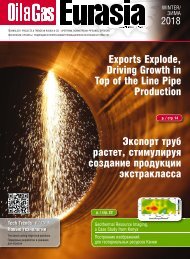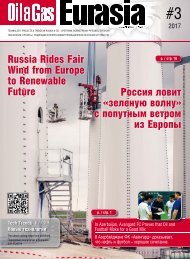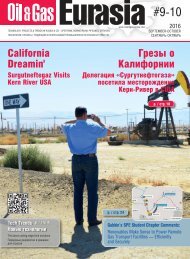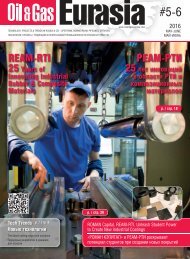Oil&Gas Eurasia July-August 2016
July-August issue of Oil&Gas Eurasia magazine
July-August issue of Oil&Gas Eurasia magazine
Create successful ePaper yourself
Turn your PDF publications into a flip-book with our unique Google optimized e-Paper software.
R&D<br />
Optimisation of Hydraulic Fracture<br />
Spacing for <strong>Gas</strong>-condensate<br />
Reservoirs<br />
Benson Lamidi Abdul-Latif, Saint Petersburg Mining University, Saint<br />
Petersburg, Russian Federation; Oppong Riverson, Gubkin Russian State Oil<br />
and <strong>Gas</strong> University, Moscow, Russian Federation<br />
Owing to the gradual depletion of conventional hydrocarbon<br />
reservoirs there is a great desire of oil producing<br />
countries to sought new hydrocarbon sources for<br />
economic, security and political reasons. Shale gas, tight gas,<br />
coldbed methane (CBM) and gas-condensate reservoirs have<br />
all become very prominent.<br />
The advent of horizontal well technology and the<br />
applications of hydraulic fracturing in horizontal gascondensate<br />
wells have played a vital role in shale gas<br />
and condensate reservoir development. The primary<br />
goal of hydraulic fracturing in horizontal gas wells is<br />
to generate a highly conductive flow path from the<br />
reservoir through the created hydraulic fracturesinto<br />
the wellbore in order to economically and technically<br />
increase gas well productivity index. The primary variables<br />
that control the productivity of a fractured well<br />
are the fracture length, the dimensionless fracture conductivity<br />
and the fracture density (fracture spacing).<br />
In moderate and high permeability wells, insufficient<br />
fracture conductivity is a limiting factor in the production<br />
potential of the well, whereas the limiting factor<br />
in tight gas reservoirs is usually the effective fracture<br />
half-length. Fracture density on the other hand plays a<br />
pivotal role in optimizing gas well deliverability in both<br />
tight and lean gas reservoirs.<br />
Even with the advent of horizontal well technology,<br />
technological challenges such as condensate banking and<br />
bottomhole pressure depletion in gas reservoirs makes<br />
gas condensate reservoirs one of the most challenging<br />
natural gas reservoirs. Condensate banking is still a major<br />
problem challenging the exploitation of gas condensate<br />
and shale gas reservoirs. Formation damage in gascondensate<br />
reservoirs are usually caused by condensate<br />
buildup around fractures and wellbore hence reducing<br />
the relative permeability to gas and thereby decreases the<br />
gas well deliverability.<br />
In a gas condensate reservoir, poor fracture density<br />
(spacing) and design might lead to lower gas production<br />
with a higher economic cost. Due to the fact that pressure<br />
gradient are usually created normal to a fracture, liquid<br />
condensates are usually formed within a fracture which is<br />
also one of the major factors affecting relative permeability<br />
to gas in the reservoir. Such permeability reductions<br />
depend on phase behavior of the fluids and penetration<br />
of liquid condensate, which in turn, depends on the pressure<br />
drawdown imposed on the well. This effect causes<br />
an apparent damage that affects the performance of all<br />
hydraulic fractures in gas-condensate wells.<br />
In this paper, optimization techniques and methods<br />
are used to determine optimal fracture design and density<br />
(spacing) using hydraulic fracturing and horizontal well<br />
technology in gas condensate reservoirs, thereby reducing<br />
fracture interference, unnecessary economic cost<br />
and minimizing fracture face damages. Using simulation<br />
methods, fracture spacing was optimized as functions of<br />
well flow rate, net present values (NPV), gas prices and<br />
gas cumulative production. Also, the effect of parameters<br />
such as permeability, pore size on phase behavior and<br />
non-Darcy flow on the production of gas-condensate reservoir<br />
is presented in this paper.<br />
Simulations results showed that higher gas prices<br />
allow for tighter fracture spacing so as to accelerate gas<br />
recovery rate and hence increases the well NPV.<br />
Also, sensitivity tools were used to identify factors<br />
affecting fracture spacing in gas condensate reservoirs.<br />
This paper also outlines optimization studies on<br />
fracture geometry (fracture length in gas-condensate<br />
reservoirs) andfracture spacing in which both analytical<br />
and numerical tools were used for several developmental<br />
scenarios in the gas-condensate reservoir environment.<br />
The design strategy for optimizing the fracture treatment<br />
once it has been decided to fracture must evidently<br />
include economic considerations. We will not carry the<br />
procedure out to the extent that the return on investment<br />
is calculated, since all of the factors including interest<br />
rates, gas prices, taxes, treatment costs, etc., will vary,<br />
making obsolete any results based on assumed values.<br />
The technical problem of optimizing fracture design and<br />
density can, however, be separated from the economic<br />
aspects if the procedure recommended here is followed.<br />
Introduction<br />
There are several challenges in a gas-condensate reservoir<br />
using horizontal and hydraulic fracturing technology.<br />
Fracture performance is always likely to be affected<br />
greatly by the presence of liquid condensate, which normally<br />
leads to fracture face damages. For unconventional<br />
reservoirs, gas-condensate become more exciting as the<br />
condensate banking effect is severer due to high-pressure<br />
drawdown from matrix to hydraulic fracture (Ismail et al,<br />
2015). Whilst most condensate banking in conventional<br />
reservoirs can be mitigated by miscible and immiscible<br />
48 Oil&<strong>Gas</strong>EURASIA











